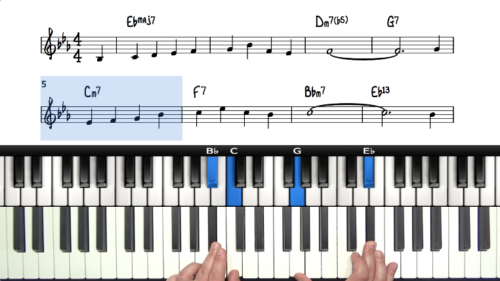Playing Outside the Changes
In this course we’re going talk about playing outside the changes and I will show few perspectives how you can start to approach the subject.
Firstly I want to point out that it is very important to know how to play inside the changes by using good, musical, strong melodies before starting to explore the possibilities of playing outside. Once you are strong with the jazz language and can hear and understand harmony you can essentially play outside the harmony by using pretty much any chord or cadence you want, as you will be able to hear the relation between the original harmony and the harmony you are playing over it.
Also I want to point out that the most important thing in making playing outside work is the way in which you resolve the melody.
Great pianists to check out for outside playing are McCoy Tyner, Herbie Hancock, Chick Corea, Kenny Kirkland and Paul Bley, just to name few.
During this course, I will be using two chords as an example: Fmaj7 and F7, or F7sus. I chose these two so we have an example of a tonic chord and a dominant chord.
Lesson Downloads
-
Playing Outside the Changes Lesson Notation File Type: pdf
Practice Tips
-
It can be difficult to transpose melodies on the fly. When trying out the half-step and constant structure ideas choose a simple melody that you can then move around. Triads and pentatonic melodies can be very effective.
-
Make sure you practice these ideas in context. Once you have a grasp on how to put one of these concepts into practice choose a tune (modal tunes are a great choice) and work on improvising over the tune.
-
Take a phrase from a transcription that includes outside playing and try to identify the structure being used. Once you have figured out the underlying theory you can use it to come up with your own lines.







Hello Tuomo, at 5’37” you refer to the Dorian scale. Is this the Dorian scale of Emajor I.e. emajor scale, root note Gb? On the previous scale, you refer to Aeolian which I understand (6th mode of E major or the natural minor). I can’t equate the notes your playing from 5’37” with Dorian (unless you are adding passing chromatic notes of course). Thanks, great lessons BTW
Hi Phil, thanks for writing!
In that part of the video I’m showing different minor scales you can use in this situation, that are “linked” to the idea of improvising over Fmaj by using C# minor. As explained in the video (04:35), we can use C#melodic minor, because that’s the source of Calt, as well as the tritone sub Gb7.
Now, just by thinking that C# minor is our go-to-platform, I am changing the quality of the C#minor to other minors than melodic,
first: aeolian (04:58) being the 6th mode of a major scale, C#aeolian derives from E major
second: dorian (05:04) being the second mode of a major scale, C#dorian derives from B major
If you look at the notes I’m playing, they are all within the C#dorian (or B major) scale (except the note F I briefly mistakenly play 🙂 )
I hope this helped, let me know if you have any further questions!
-Tuomo